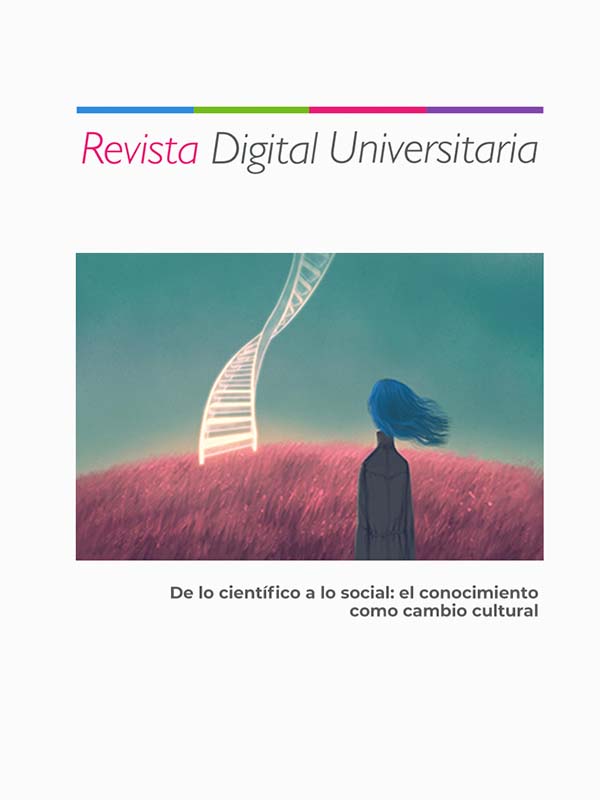Camarón que se desecha se pierde: la fermentación láctica como solución
DOI:
https://doi.org/10.22201/ceide.16076079e.2025.26.1.6Palabras clave:
Fermentación láctica, residuos de camarón, antioxidantes naturales, valoración de residuos, quitinaResumen
Los residuos de camarón son una fuente importante de compuestos industriales, como la quitina. Sin embargo, a pesar de los estudios realizados, estos residuos no se aprovechan completamente. Actualmente, solo se utiliza un proceso químico para obtener quitina, pero este método no permite recuperar otros componentes valiosos como proteínas y carotenoides, y consume grandes cantidades de agua y energía. Por ello, se han explorado alternativas más eficientes. La fermentación láctica (fl) ha demostrado ser una estrategia económica y eficaz para aprovechar los residuos de camarón. Este proceso genera dos fases: una sólida y una líquida (licor), que contienen proteínas hidrolizables, minerales, ácidos grasos poliinsaturados, carotenoides y quitina. Estos productos tienen potencial para ser utilizados como fuentes de antioxidantes, antiinflamatorios, inmunomoduladores y en la formulación de alimentos. De este modo, la fl de los residuos de camarón no solo contribuye a la reducción de problemas ambientales, sino que también añade valor a los desechos de la industria pesquera.
→ Leer más
Citas
Encyclopaedia Britannica (2024). “enzyme” en Encyclopedia Britannica, 22 Jul. 2024, https://www.britannica.com/science/enzyme.
Cabanillas-Bojórquez, L. A., Gutierrez-Grijalva, E. P., Castillo-Lopez, R. I., Contreras-Angulo, L. A., Angulo-Escalante, M. A., Lopez-Martinez, L. X., Rios-Iribe, M. A. y Heredia, J. B. (2021)a. Bioprocessing of Shrimp Waste Using Novel Industrial By-Products: Effects on Nutrients and Lipophilic Antioxidants. Fermentation, 7(4), 312. https://doi.org/10.3390/fermentation7040312.
Cabanillas-Bojórquez, L. A., Gutierrez-Grijalva, E. P., Gonzalez-Aguilar, G. A., Lopez-Martinez, L. X., Castillo-Lopez, R. I., Bastidas-Bastidas, P. D., y Heredia, J. B. (2021)b. Valorization of Fermented Shrimp Waste with Supercritical CO2 Conditions: Extraction of Astaxanthin and Effect of Simulated Gastrointestinal Digestion on Its Antioxidant Capacity. Molecules, 26(15), 4465. https://doi.org/10.3390/molecules26154465.
Cabanillas-Bojórquez, L. A., Montes-Avila, J., Vega-Garcia, M. O., Lopez-Moreno, H. S., Castillo-Lopez, R. I., y Gutierrez-Dorado, R. (2023). Effect of Optimized Chitosan Coating Obtained by Lactic Fermentation Chemical Treatment of Shrimp Waste on the Post-Harvest Behavior of Fresh-Cut Papaya (Carica papaya L.). Fermentation, 9(3), 220. https://doi.org/10.3390/fermentation9030220.
Canpulat, M., Pinar, O., Yilmaz-Sercinoglu, Z., y Kazan, D. (2022). Valorization of shrimp waste by obligate alkaliphilic Bacillus marmarensis. Biomass Conversion and Biorefinery. https://doi.org/10.1007/s13399-022-03684-7.
conapesca (2024). Se posiciona México como el segundo mejor productor de camarón en Latinoamérica. Comisión Nacional de Acuacultura y Pesca. https://www.gob.mx/conapesca/prensa/se-posiciona-mexico-como-el-segundo-mejor-productor-de-camaron-en-latinoamerica?idiom=es-MX.
Doan, C. T., Tran, T. N., Nguyen, V. B., Vo, T. P. K., Nguyen, A. D., y Wang, S. L. (2019). Chitin extraction from shrimp waste by liquid fermentation using an alkaline protease-producing strain, Brevibacillus parabrevis. International Journal of Biological Macromolecules, 131, 706-715. https://doi.org/10.1016/j.ijbiomac.2019.03.117.
Peña García, P., Querevalú Ortiz, J., Ochoa Mogollón, G., y Sánchez Suárez, H. (2020). Boilogical silage of shrimp waste fermented with lactic acid bacteria: Use as a biofertilizer in pasture crops and as feed for backyard pigs. Scientia Agropecuaria, 11(4), 459-471. https://doi.org/10.17268/sci.agropecu.2020.04.01.
Gharibzadeh, M., Osfouri, S., Jamekhorshid, A., y Jafari, S. A. (2023). Microbial chitin extraction and characterization from green tiger shrimp waste: A comparative study of culture mediums along with bioprocess optimization. International Journal of Biological Macromolecules, 242, 125213. https://doi.org/10.1016/j.ijbiomac.2023.125213.
Hamdi, S. A. H., Ghonaim, G. M., El Sayed, R. R., Rodriguez-Couto, S., y Abd El-Ghany, M. N. (2024). Bioprocess of astaxanthin extraction from shrimp waste via the common microorganisms Saccharomyces cerevisiae and Lactobacillus acidophilus in comparison to the chemical method. Biomass Conversion and Biorefinery, 14(7), 8333-8339. https://doi.org/10.1007/s13399-022-02984-2.
Jafari, R., Homaei, A., Ahmadi, A. R., y Kamrani, E. (2023). Optimization and identification of astaxanthin esters from shrimp waste using microbial fermentation method. Biomass Conversion and Biorefinery, 1-16. https://doi.org/10.1007/s13399-023-04398-0.
Leiva-Portilla, D., Martinez, R., y Bernal, C. (2023). Valorization of shrimp (Heterocarpus reedi) processing waste via enzymatic hydrolysis: Protein extractions, hydrolysates and antioxidant peptide fractions. Biocatalysis and Agricultural Biotechnology, 48, 102625. https://doi.org/10.1016/j.bcab.2023.102625.
Malik, V. S., y Hu, F. B. (2015). Fructose and cardiometabolic health: what the evidence from sugar-sweetened beverages tells us. Journal of the American College of Cardiology, 66(14), 1615-1624. https://doi.org/10.1016/j.jacc.2015.08.025.
Navarrete-Bolanos, J. L., Gonzalez-Torres, I., Vargas-Bermudez, V. H., y Jimenez-Islas, H. (2020). A Biotechnological Insight to Recycle Waste: Analyzing the Spontaneous Fermentation of Shrimp Waste to Design the Hydrolysis Process of Chitin into N-Acetylglucosamine. Revista Mexicana De Ingenieria Quimica, 19(1), 263-274. https://doi.org/10.24275/rmiq/Bio544.
Suresh, P. V., Kudre, T. G., y Johny, L. C. (2018). Sustainable Valorization of Seafood Processing By-Product/Discard (E. Int Soc, C. I. Environm Sustainabil, G. I. D. S. Appl Bioprocessing, y T. S. I. T. A. V. L. H. S. Technol, Trans.). In R. R. Singhania, R. A. Agarwal, R. P. Kumar, y R. K. Sukumaran (Eds.), Waste to Wealth. Energy, Environment, and Sustainability. (pp. 111-139). Mohali, INDIA: Springer Nature. https://doi.org/10.1007/978-981-10-7431-8_7.
Ximenes, J. C. M., Hissa, D. C., Ribeiro, L. H., Rocha, M. V. P., Oliveira, E. G., y Melo, V. M. M. (2019). Sustainable recovery of protein-rich liquor from shrimp farming waste by lactic acid fermentation for application in tilapia feed. Brazilian Journal of Microbiology, 50(1), 195-203. https://doi.org/10.1007/s42770-018-0024-3.
Xin, R. Y., Xie, W. C., Xu, Z. Y., Che, H. X., Zheng, Z. X., y Yang, X. H. (2020). Efficient extraction of chitin from shrimp waste by mutagenized strain fermentation using atmospheric and room-temperature plasma. International Journal of Biological Macromolecules, 155, 1561-1568. https://doi.org/10.1016/j.ijbiomac.2019.11.133.
Zhou, Y., Guo, N., Wang, Z. M., Zhao, T. Y., Sun, J. A., y Mao, X. Z. (2021). Evaluation of a clean fermentation-organic acid method for processing shrimp waste from six major cultivated shrimp species in China. Journal of Cleaner Production, 294, 126135. https://doi.org/10.1016/j.jclepro.2021.126135.
Publicado
Número
Sección
Licencia
Derechos de autor 2025 Revista Digital Universitaria

Esta obra está bajo una licencia internacional Creative Commons Atribución-NoComercial-CompartirIgual 4.0.

Revista Digital Universitaria es editada por la Universidad Nacional Autónoma de México se distribuye bajo una Licencia Creative Commons Atribución-NoComercial 4.0 Internacional. Basada en una obra en http://revista.unam.mx/.










